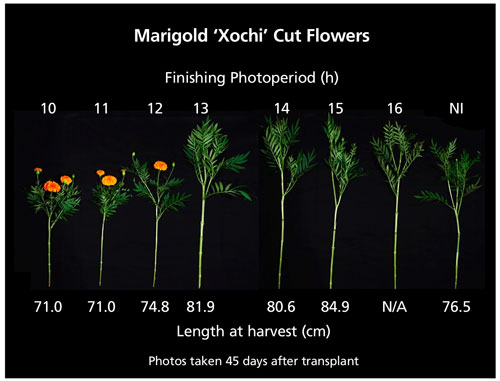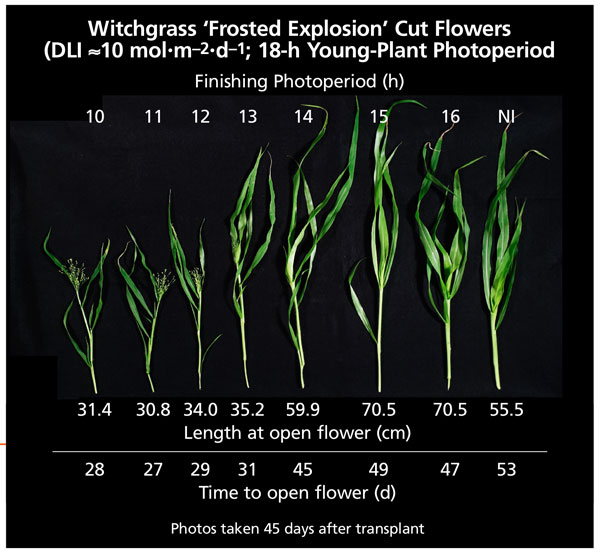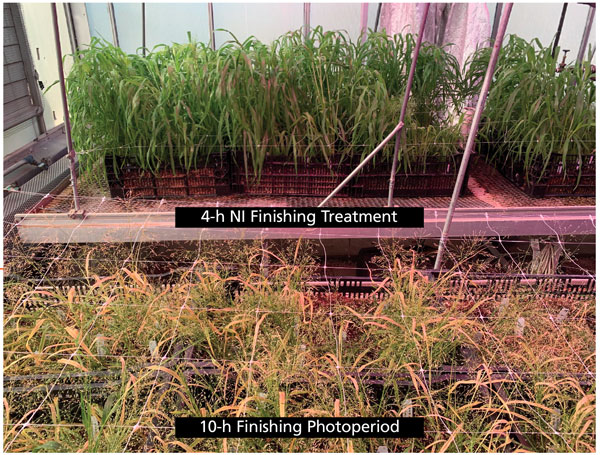7/1/2022
Emerging Specialty Cut Flowers
Caleb Spall & Roberto Lopez

With the resurgence of year-round demand for locally grown, exciting and fresh flowers, growers across the nation are increasingly interested in adding specialty cut flowers to their product line to tap into local and regional markets, and satisfy consumer demand. Specialty cut flowers—flowers other than roses, carnations and chrysanthemums—encompass a wide variety of colorful, textural and eye-catching herbaceous and woody cut flowers.
Figure 1: Marigold Xochi (Tagetes erecta) cut flowers grown under a 10-, 11-, 12-, 13-, 14-, 15- or 16-hour photoperiod, or a four-hour night interruption (NI) from 10:00 p.m. to 2:00 a.m.
A large portion of domestic specialty cut flower production takes place in California because of its favorable environmental conditions for outdoor cut flower production, i.e., year-round moderate temperatures and light intensities. However, demand persists across the nation, even in northern latitudes that experience low temperatures and light intensities during the winter and early spring. Additionally, naturally short photoperiods during these seasons can impact what can be grown without daylength regulation.
To compensate for these setbacks, growers in northern regions must utilize greenhouses to provide the required temperatures, light intensities and daylengths for specialty cut flower production. Current research on how the greenhouse light environment affects growth and development of specialty cut flowers is limited. However, photosynthetic and photoperiodic lighting remains of paramount importance from the day seeds are sown until the day the last cut flower is harvested, as they can significantly influence time to flower and harvest, as well as finished cut flower quality and yield.
Flower induction (initiation and development) of many specialty cut flowers occurs in response to daylength. Plants can be categorized as short-day plants (SDPs), long-day plants (LDPs) and day-neutral plants (DNPs). SDPs and LDPs flower when the daylength is shorter or longer than a critical photoperiod, respectively, whereas DNPs do not flower in response to daylength. SDPs and LDPs can be further classified as facultative (quantitative) or obligate (qualitative), where a photoperiod shorter or longer than a critical photoperiod hastens flowering, or is required for flowering,
respectively.
When the natural photoperiod isn’t consistent with your crop’s photoperiodic requirement, or if your crop is at risk of premature flowering, measures can be taken to regulate the daylength. The daylength can be shortened by covering your crop with black cloth and excluding light. Conversely, low-intensity photoperiodic lighting can be applied from sunset to a specific time of the night (day extension; DE lighting) or during a period of four hours from 10:00 p.m. to 2:00 a.m. in the middle of the night (night interruption; NI lighting) to create long-day (LD) conditions.
Regardless of where your growing operation is located, daylength regulation can help you produce high-quality cuts year-round. If daylength regulation isn’t taken into consideration when cuts are just seedlings or rooted cuttings (i.e., plugs or liners), plants may flower too early or late, meaning short, unmarketable stems or delayed crop cycles, respectively. For instance, when the natural days are short, LDPs can be maintained with low-intensity photoperiodic lighting to prevent premature flowering to ensure sufficient cut flower stem lengths are met before flower induction occurs.
 Figure 2: Witchgrass Frosted Explosion (Panicum capillare) stems grown under an 18-hour young-plant photoperiod and finished under a 10-, 11-, 12-, 13-, 14-, 15- or 16-hour photoperiod, or a four-hour NI from 10:00 p.m. to 2:00 a.m.
Figure 2: Witchgrass Frosted Explosion (Panicum capillare) stems grown under an 18-hour young-plant photoperiod and finished under a 10-, 11-, 12-, 13-, 14-, 15- or 16-hour photoperiod, or a four-hour NI from 10:00 p.m. to 2:00 a.m.
Furthermore, light intensity from the sun can be greatly reduced during the winter and early spring in extreme latitudes. Low-light intensities can slow production time and produce elongated, thin and weak stems. Additionally, plants grown under low-light levels typically have fewer and smaller flowers with a duller hue. To account for reduced solar radiation, and to avoid these undesirable crop traits, growers may need to use high-intensity supplemental lighting (SL) to boost photosynthetic light levels within their greenhouses.
What did we find?
We grew seedlings of Marigold Xochi (Tagetes erecta) and Witchgrass Frosted Explosion (Panicum capillare) under various photoperiods for two weeks [nine-, 11- (marigold only), 12-, 13-, 14-, 15-, 16-, 18- or 24-hour photoperiods or a four-hour NI from 10:00 p.m. to 2:00 a.m.]. Afterwards, we transplanted seedlings from various young-plant photoperiods across several other photoperiods for finishing (10-, 11-, 12-, 13-, 14-, 15- or 16-hour photoperiods, or a four-hour NI from 10:00 p.m. to 2:00 a.m.).
Additionally, witchgrass was grown under either a very low light intensity (≈3 mol•m–2•d–1) or a moderate light intensity (≈10 mol•m–2•d–1). Plants were monitored daily for the presence of first visible buds (VBs), open flowers (OFs) and harvestability [≥26 in. (≥65 cm with a half open flower head for marigold); ≥20 in. (≥50 cm long) with a fully developed panicle for witchgrass].
We confirmed that both crops are facultative short-day plants, meaning that they’ll flower faster under short days, but will eventually flower under long days. We also found that any photoperiod between 11 and 24 hours, or a four-hour NI during the young-plant stage and a finishing photoperiod of 12 hours produced high-quality marigold cut flowers that were over 25-in. (65-cm) tall with thick stems and large, vibrant flower heads.
While the young-plant photoperiod didn’t commercially influence time to flower, harvest and finished quality, marigolds produced flower buds up to 15 days faster when grown under a 10-hour finishing photoperiod compared to a 16-hour photoperiod. While 10- and 11-hour finishing photoperiods produced harvestable cut flowers, roughly double the amount of cut flowers were harvestable under the 12-hour photoperiod. Additionally, these cut flowers were roughly 1.6 in. (4 cm) taller than those grown under the 10-hour photoperiod treatment (Figure 1). Furthermore, plants grown under photoperiods >12 hours hadn’t flowered after eight weeks, but had developed buds and would be considered marketable within several more weeks.
Moreover, high-quality witchgrass cut flowers were produced when the young-plant photoperiod was between 14 and 24 hours, or a four-hour NI, and the finishing photoperiod was equal to or greater than 14 hours, or a four-hour NI. When witchgrass was grown under photoperiods shorter than these during the young plant or finishing stages, flowering occurred prematurely, and plants were too thin and short to meet market specifications.
For instance, plants grown under a nine-hour young-plant photoperiod flowered within two weeks of transplant, regardless of the finishing photoperiod. These plants were up to 81% shorter and 80% thinner than those grown under the recommended photoperiods previously described. Moreover, plants finished under 10- to 13-hour photoperiods were up to 88% shorter and 87% thinner than those grown under the longer photoperiods. The influence of finishing photoperiod on witchgrass grown under 18-hour young-plant photoperiods can be seen in Figure 2.
 In Figure 3, differences between plants finished under a 10-hour photoperiod or a four-hour NI at the end of the study can be seen. Furthermore, harvestable witchgrass stems were only produced under a moderate light intensity. No plants were harvestable when grown under a very low light intensity, regardless of the photoperiod. Plants grown under a very low light intensity were generally shorter and had weak stems compared to those grown under a moderate light intensity.
In Figure 3, differences between plants finished under a 10-hour photoperiod or a four-hour NI at the end of the study can be seen. Furthermore, harvestable witchgrass stems were only produced under a moderate light intensity. No plants were harvestable when grown under a very low light intensity, regardless of the photoperiod. Plants grown under a very low light intensity were generally shorter and had weak stems compared to those grown under a moderate light intensity.
Figure 3: Witchgrass Frosted Explosion (Panicum capillare) finished under either a 10-hour photoperiod or a four-hour NI and a moderate light intensity. Plants finished under the 10-hour photoperiod flowered prematurely and no harvestable stems were produced. A four-hour NI delayed flowering long enough for sufficient stem lengths to be met, yielding a harvestable crop.
Implications for greenhouse cut flower production
We found that the critical photoperiods of marigold and witchgrass were 12 hours and 13 hours, respectively. While marigold was generally harvestable and marketable when grown under daylengths shorter than the critical photoperiod, witchgrass grown under daylengths shorter than its critical photoperiod flowered prematurely and plants weren’t of sufficient quality for sale (Figure 2).
It’s important to understand the photoperiodic flowering responses of your crops to avoid premature flowering, reduced yields and poor crop quality. Witchgrass flowered prematurely regardless of finishing photoperiod when it was grown under nine- to 13-hour photoperiods for the two-week-long young-plant stage. However, this crop loss could be prevented by maintaining long days from the beginning of the crop cycle. Conversely, it may be beneficial to maintain short days during the beginning of an LDP crop cycle to prevent premature flowering.
Additionally, we recommend that a moderate light intensity of 10 mol•m–2•d–1 or greater be maintained throughout the crop cycle to produce high-quality specialty cut flowers. Witchgrass grown under a very low DLI was of poor quality and not considered harvestable compared to those grown under a moderate light intensity. Thus, it’s critical that growers in extreme latitudes utilize SL to maintain sufficient light intensities during the production of specialty cut flowers. GT
Acknowledgements: We thank J.R. Peters for fertilizer, Hydrofarm for netting, PanAmerican Seed for seeds, and Raker Roberta’s for sowing and trays. This study was supported by BloomStudios and the Association of Specialty Cut Flower Growers.
Caleb Spall is an M.S. student and Roberto Lopez is an Associate Professor and Controlled Environment/Floriculture Extension Specialist in the Department of Horticulture at Michigan State University.